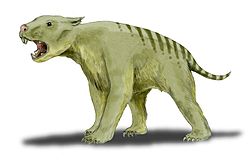| Rhizophascolonus Temporal range: | |
|---|---|
| Scientific classification | |
| Kingdom: | Animalia |
| Phylum: | Chordata |
| Class: | Mammalia |
| Infraclass: | Marsupialia |
| Order: | Diprotodontia |
| Family: | Vombatidae |
| Genus: | † Rhizophascolonus Stirton et al., 1967 |
| Type species | |
| Rhizophascolonus crowcrofti Stirton et al., 1967 | |
| Other species | |
| |
Rhizophascolonus is an extinct genus of wombat known from the Early Miocene of South Australia. [1] [2] The genus was first described to accommodate Rhizophascolonus crowcrofti, in 1967. A discovery at Riversleigh was published as another new species in 2018, Rhizophascolonus ngangaba, and further specimens from this area were assigned to R. crowcrofti in the same study. [3]

